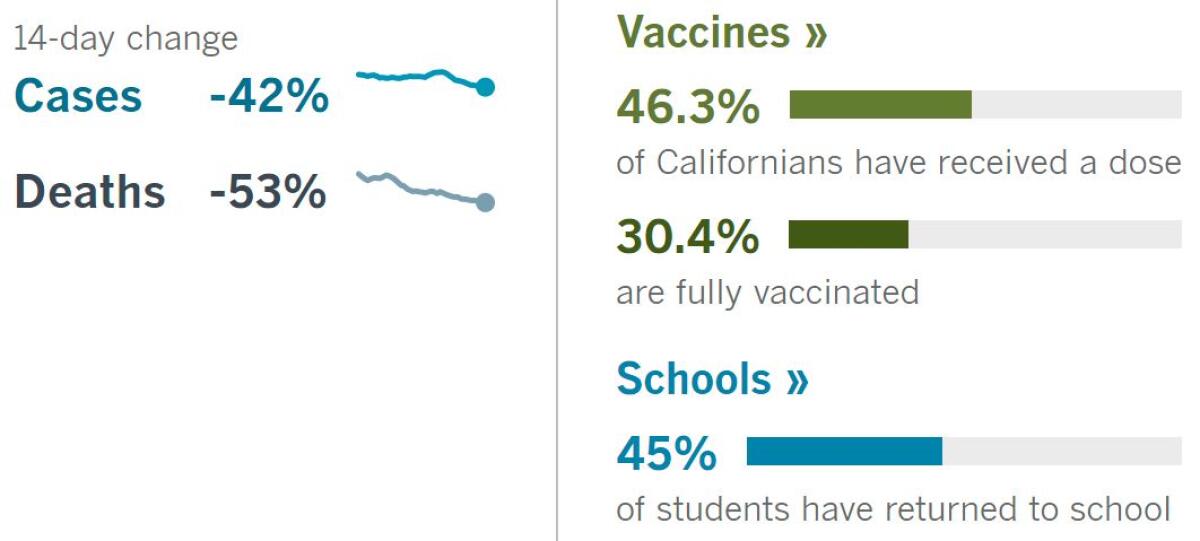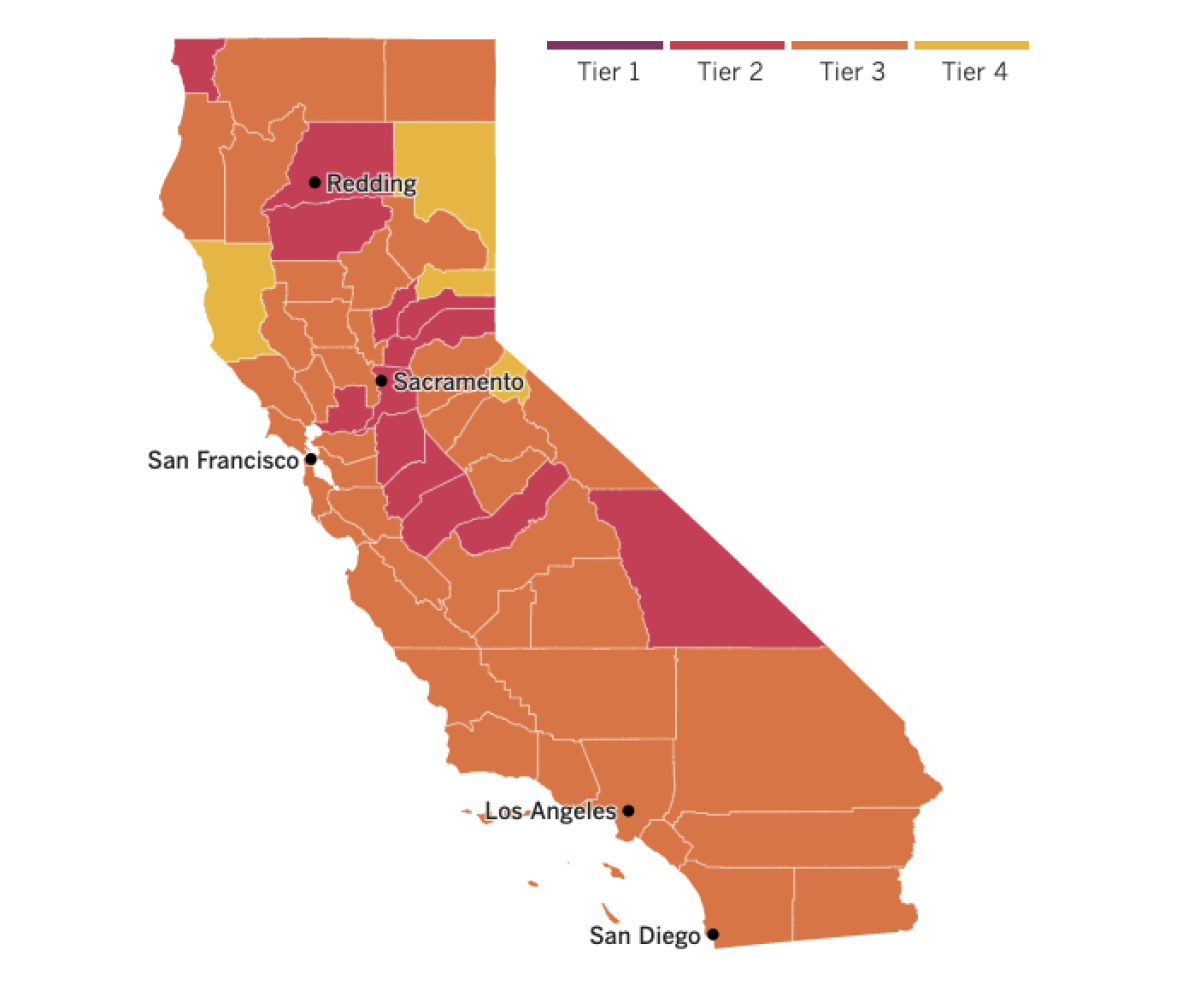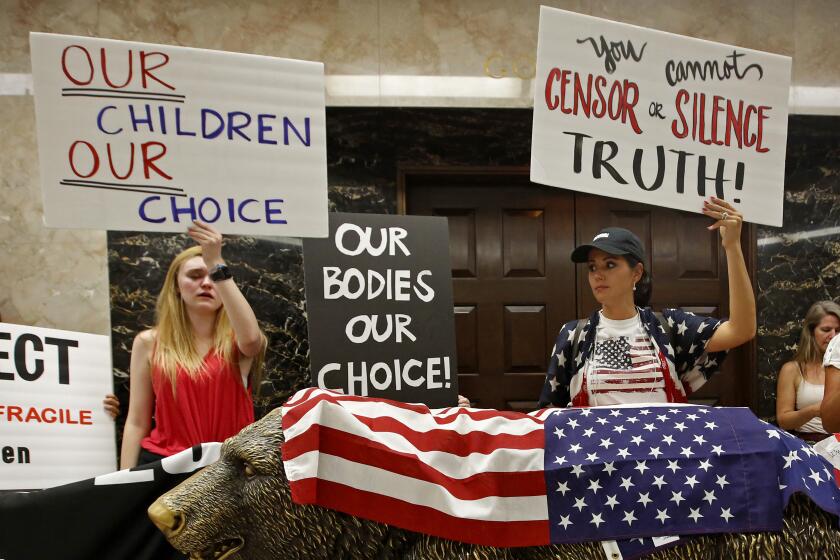Coronavirus Today: We’re going to Disneyland!
- Share via
Good evening. I’m Thuc Nhi Nguyen, and it’s Thursday, April 29. Here’s what’s happening with the coronavirus in California and beyond.
Let’s face it: We could all use a little more happiness in our lives.
Well, here’s Disneyland to the rescue.
The “Happiest Place on Earth” is set to reopen Friday for the first time in more than a year, and the employees who run the park couldn’t be more thrilled to return. Yes, the paychecks will be a welcome sight for people who have been getting by on unemployment and side hustles, but my colleague Hugo Martín reports that the thing staff members are looking forward to most is seeing park patrons — even if their smiles are hidden behind masks.
“The park was not meant to be empty and lifeless,” said Austin Leonard, who will reprise his role as a stage manager at Star Wars: Galaxy’s Edge when the park reopens. “It’s truly meant to have energy and life in it.”
Disneyland and Disney California Adventure Park must follow the state’s pandemic safety guidelines when they reopen. They’ll also have to honor an agreement between the company and labor union leaders regarding safety precautions for workers, including the enforcement of physical distancing, temperature checks, indoor ventilation, sick pay and job retention measures.
To start, the parks will be capped at 25% of their usual capacity, and there will be temperature check booths for visitors and coronavirus testing facilities for employees. As state health guidelines allow parks to increase their attendance, more workers will be hired back, Disney representatives say.
Employees like Austin Lynch, a union organizer at Unite Here Local 11 that represents hotel and food service workers at the resort, believe it’s safe to return to work now.
That wasn’t the case when Disney tried to reopen in June amid a rise in coronavirus cases. The premature attempt was thwarted by an online petition with more than 56,000 signatures and a 200-car caravan that rolled around the resort to protest the reopening plans.
The year of quiet in the parks has resulted in some updates to popular attractions such as the Haunted Mansion. A new Avengers Campus will open in June. Discussions about racial injustice over the past year also forced the park to rethink some of its historic rides, including Splash Mountain, which will replace imagery rooted in the racist 1946 film “Song of the South” with a narrative based on “The Princess and the Frog,” a 2009 animated movie that starred Disney’s first Black princess.
Not all rides will be up and running by Friday, but it’s “a sign of relief that things are getting back to normal,” said Eric Jimenez, an officer with Teamsters Local 952, which represents employees who operate heavy equipment and maintain and repair attractions and machinery around the parks.
Only one of the resort’s three hotels — Disney’s Grand Californian Hotel & Spa — will be up and running when the parks reopen, but others will follow. For Glynndana Shevlin, whose post at the Disneyland Hotel hasn’t opened yet, that means waiting by her phone a bit longer.
“I’m ready to put on my uniform,” the 32-year Disneyland veteran said.
By the numbers
California cases, deaths and vaccinations as of 5:57 p.m. Thursday:

Track California’s coronavirus spread and vaccination efforts — including the latest numbers and how they break down — with our graphics.

Across California
Once you’re done getting reacquainted with Disneyland, maybe you’ll consider cooling off at a water park.
California has released new guidance for water parks to reopen, setting limits on capacity based on the state’s reopening plan. As of this week, 41 of California’s 58 counties — including Los Angeles, Orange, San Diego and Santa Clara — are in the orange tier, where the outdoor capacity at water parks is set at 25% and indoor areas can be open at 15% capacity.
In the most lenient yellow tier, where L.A. could move next week, outdoor areas are capped at 40% capacity, with 25% allowed in indoor areas.
Masks are required for visitors except while eating or drinking or when the face covering would get wet. Wearing a mask in the water could make it difficult to breathe and wet fabric may compromise the mask’s function, the state’s guideline said. For that reason, social distancing while in the water is especially important and patrons are encouraged to bring more than one mask.
Right now, California is swimming in so much vaccine that counties are turning shipments down — but even so, some vulnerable people are being left high and dry.
Pharmacies advertise the shots but then turn away elderly vaccine hopefuls by telling them to make an appointment online first. The only problem is that not everyone has access to the technology to make a reservation. Others who are homebound can’t get to a vaccination site at all.
“It’s not as easy as putting up a mass vaccination site and saying if you build it, they will come,” said Dr. Kirsten Bibbins-Domingo, epidemiology and biostatistics chair at UC San Francisco.
We’ve received several questions from readers about how homebound people can get their vaccines, and unfortunately, there’s no good answer yet.
Last month, my colleague Lila Seidman reported on grass-roots groups working to reach homebound seniors, including efforts from USC’s Keck School of Medicine, UCLA Health and the Glendale Fire Department and a local hospital.
Some of them, including the L.A. County Sheriff’s “Operation Homebound,” were knocked off course when use of the Johnson & Johnson vaccine was briefly suspended over concerns about a rare blood-clotting disorder. The single-dose shot doesn’t require storage at freezing temperatures, making it easier to deliver to patients in their homes.
Those efforts may get back on track soon. California is poised to receive almost 90,000 doses of the J&J shot next week after U.S. officials cleared it for use again. The expected delivery would be the first direct federal shipment of J&J shots since the pause went into effect the week of April 12. Vaccination rates in the state — and elsewhere — have dropped since the halt.
L.A. County officials are alarmed by a 50% plunge in first-dose vaccination appointments. To address the slowdown, L.A. County Public Health Director Barbara Ferrer said all county-run vaccination sites are accepting walk-in appointments this week and are likely to continue doing so next week. She also said officials will focus on “bring[ing] the vaccine close to where you already are at.”


See the latest on California’s coronavirus closures and reopenings, and the metrics that inform them, with our tracker.
Consider subscribing to the Los Angeles Times
Your support helps us deliver the news that matters most. Become a subscriber.
Around the nation and the world
With vaccination cards in hand and antibodies multiplying, more Americans are stepping out of quarantine and resuming old rhythms of life. The U.S. economy is feeling the effects, my colleague Don Lee reports.
During the first quarter of 2021, gross domestic product (the value of all the goods and services produced in the nation) grew at an annual rate of 6.4%, and the real GDP (which is adjusted for inflation) rose by 4.3%. Now the real GDP is only slightly below where it was at the end of 2019, marking a swift recovery from the worst downturn since the Great Depression.
The rebound is likely to grow even more if vaccination rates continue to rise and the coronavirus is kept at bay. We could be on track for 2021 to log the fastest growth since the 1980s.
But it’s not entirely positive news. The recovery is “uneven and far from complete,” Federal Reserve Board Chairman Jerome H. Powell warned. Corporations and higher-income individuals have been the ones benefiting as ultra-low interest rates propelled stock prices, home values and company profits.
Unemployment is still high among restaurant workers, Black and Latino people, and people with disabilities. Experts anticipate that as economic activity kicks into gear, the recovery will spread to more lower-income households.
One troubled industry has a chance at a comeback after the Centers for Disease Control and Prevention outlined new ways for cruise ships to sail from U.S. ports again.
In a letter sent to cruise companies, the CDC advised that ships can launch with paying customers if 95% of guests and 98% of crew members are vaccinated. The CDC said it wants to resume U.S. cruises “as soon as possible to maintain the timeline of passenger voyages by mid-July.”
Cruises have essentially been shut out of U.S. ports since the beginning of the pandemic. The CDC lifted its ban on cruises in October, but the checklist required to set sail again was so cumbersome that no operators could meet it.
You may remember early-pandemic horror stories of cruise ships stuck on the water for weeks when coronavirus outbreaks prevented them from docking. But the reboot in other countries has proceeded with less drama: Royal Caribbean said it has carried more than 125,000 guests since cruises resumed overseas, with just 21 people testing positive for the coronavirus.
If the chance to go on a safe cruise this summer isn’t enough to convince you to get vaccinated, how about a free beer, a doughnut or a savings bond?
Companies and public health officials are getting creative to convince Americans to roll up their sleeves since traditional media campaigns and public service announcements are starting to fall on deaf ears.
In Detroit, officials are offering $50 to people who give others a ride to vaccination sites. A $100 savings bond is available to young adults who get their shots in West Virginia. Some breweries are giving away a “shot and chaser,” while Krispy Kreme hands out a sweet, glazed treat to those with their vaccine cards.
Employers are helping out too, with some giving their workers additional paid time off to get vaccinated and rest after any possible side effects.
In northeastern Washington state, demand for COVID-19 vaccines has dropped so dramatically that Matt Schanz, administrator of the Northeast Tri County Health District, worries that only a new outbreak will revive interest. That could happen soon: At the beginning of March, the state was reporting about 700 new coronavirus cases a day. Now the count is almost 1,400.
In Mexico, a country of 126 million that is trying to speed up its vaccination effort, a study has shown that as much as one-third of the population may have been exposed to the coronavirus by the end of 2020.
Antibodies were found in 33.5% of tested blood samples that were taken between December and February. The samples came from Mexican blood banks and from medical laboratories that processed tests unrelated to COVID-19.
Antibody levels varied from region to region and were highest in areas along the U.S. border.
The study suggested that about 86% of those infected had developed effective antibodies, but the other 14% hadn’t, leaving them open to possible reinfection. That’s a reason why even people who have recovered from a coronavirus infection should get vaccinated.
Mexico has administered almost 17 million shots to more than 12 million people. The country is expecting to receive more doses of the Pfizer-BioNTech vaccine from U.S. plants, which are easier to import than shots from European plants.
Mexico has vaccinated many of its senior citizens and plans to begin vaccinating people between the ages of 50 and 59 in May.
Your questions answered
Today’s question comes from readers who want to know: How are the COVID-19 vaccines tested in kids?
The first COVID-19 vaccine rolled out in the U.S. was authorized for use in people 16 and up. But the U.S. Food and Drug Administration needs more clinical trial data before allowing any of the vaccines to go into the arms of infants, toddlers, children and younger teens, since they weren’t included in the initial tests.
The necessary trials are now underway. Vaccine makers start with adolescents and work their way down to younger kids. The safety and effectiveness of the Pfizer-BioNTech vaccine are being tested in children as young as 2, and Moderna has already started testing its vaccine in babies as young as 6 months.
The first stage of these trials focuses on finding the best dosage. For example, participants between the ages of 2 and 11 in Moderna’s trial receive either 50 or 100 micrograms per dose, while those ages 6 months to just under 24 months will get 25, 50 or 100 micrograms per dose. (For comparison, each Moderna dose for adults is 500 micrograms.) Similar to the adult shots, each child will get two doses, 28 days apart. Researchers are looking for the best balance between immune response and side effects.
Once the appropriate dosage is determined for each age group, it is tested against a placebo. Trial participants are randomly assigned to receive one or the other — they won’t know which — and they’ll be tracked for a year to see how the vaccine works compared to the dummy shots.
In adult trials, analyzing the effectiveness of the vaccines meant comparing the rates of COVID-19 between the two groups. But children don’t get coronavirus infections as often, so there may not be enough cases of COVID-19 among the testers for a comparison like that to be statistically meaningful. In that case, researchers can also study the immune responses of kids and see if they are comparable to the ones seen in adults.
We want to hear from you. Email us your coronavirus questions, and we’ll do our best to answer them. Wondering if your question’s already been answered? Check out our archive here.
Resources
Need a vaccine? Sign up for email updates, and make an appointment where you live: City of Los Angeles | Los Angeles County | Kern County | Orange County | Riverside County | San Bernardino County | San Diego County | San Luis Obispo County | Santa Barbara County | Ventura County
Need more vaccine help? Talk to your healthcare provider. Call the state’s COVID-19 hotline at (833) 422-4255. And consult our county-by-county guides to getting vaccinated.
Practice social distancing using these tips, and wear a mask or two.
Watch for symptoms such as fever, cough, shortness of breath, chills, shaking with chills, muscle pain, headache, sore throat and loss of taste or smell. Here’s what to look for and when.
Need to get tested? Here’s where you can in L.A. County and around California.
Americans are hurting in many ways. We have advice for helping kids cope, resources for people experiencing domestic abuse and a newsletter to help you make ends meet.
We’ve answered hundreds of readers’ questions. Explore them in our archive here.
For our most up-to-date coverage, visit our homepage and our Health section, get our breaking news alerts, and follow us on Twitter and Instagram.




